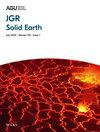泄漏模态约束下断层破坏带的纵波速度:在2019年脊峰余震序列中的应用
IF 4.1
2区 地球科学
Q1 GEOCHEMISTRY & GEOPHYSICS
引用次数: 0
摘要
断层附近的破坏带是由多次地震破裂形成的。它们是影响地震成核和动力破裂的重要构造。目前关注损伤区结构成像的方法不多,但大多只得到剪切速度(v)的减少。泄漏模式是一种特殊类型的波传播在低速区,其能量泄漏到高速层,与困波。泄漏模态和捕获S波在时间上是分离的,占不同分量,其中泄漏模态对压缩波(Vp)结构更为敏感。我们提出用泄漏模态来约束损伤区的纵波速度结构。在这项研究中,我们发展了如何在一个简单的夹层低速结构中使用泄漏模态的特征频率来约束Vp参数的理论。首先,我们讨论了泄漏模态的声学近似,证明了高Vp/Vs比损伤区泄漏模态特征频率区间的预测是合理的。其次,我们讨论了不同传播距离和Vp/Vs比下泄漏模态的发展,并从模拟波形中提取了泄漏模态的特征频率。我们证明了泄漏模态的特征频率区间接近于声学解,并且对Vp降低更敏感。第三,我们从2019年Ridgecrest地震断裂带东南侧观测到的泄漏模式存在的Ridgecrest余震序列中选择了73个事件,提取了3个特征频率(7.64、10.47和14.59 Hz)。最后,我们约束了Vp降低与损伤区宽度之间的关系,表明在B4阵列下P波速度降低了14%-29%。本文章由计算机程序翻译,如有差异,请以英文原文为准。
Compressional Wave Velocity of Fault Damage Zones Constrained by Leaky Modes: Application to the 2019 Ridgecrest Aftershock Sequence
Damage zones near a fault are formed by multiple seismic ruptures. They are important structures that influence the nucleation and dynamic rupture of earthquakes. There have been a few methods focusing on imaging damage zone structures, and most of them only obtain shear velocity (Vs) reduction. The leaky mode is a special type of wave propagation in low‐velocity zones, whose energy leaks into high‐velocity layers, contrasting with trapped waves. Leaky mode and trapped S‐waves are separated in time and dominate different components, with leaky mode being more sensitive to compression wave (Vp) structures. We propose applying the leaky mode to constrain the P‐wave velocity structure of a damage zone. In this study, we develop the theory of how to use the characteristic frequency of leaky modes to constrain the Vp parameters in a simple sandwiched low‐velocity structure. First, we discuss the acoustic approximation of leaky modes, demonstrating that it is reasonable to predict the characteristic frequency interval of leaky modes for damage zones with high Vp/Vs ratios. Secondly, we discuss the development of leaky modes for different propagation distances and Vp/Vs ratios and extract the characteristic frequency of leaky modes from simulated waveforms. We demonstrate that the characteristic frequency interval of leaky modes is close to the acoustic solution and is more sensitive to Vp reduction. Thirdly, we selected 73 events from the Ridgecrest aftershock sequence on the southeast side of the 2019 Ridgecrest earthquake rupture zone, where well‐observed leaky modes were present, and extracted three characteristic frequencies (7.64, 10.47, and 14.59 Hz). Finally, we constrain the relationship between Vp reduction and damage zone width, indicating a 14%–29% P‐wave velocity reduction under the B4 array.
求助全文
通过发布文献求助,成功后即可免费获取论文全文。
去求助
来源期刊

Journal of Geophysical Research: Solid Earth
Earth and Planetary Sciences-Geophysics
CiteScore
7.50
自引率
15.40%
发文量
559
期刊介绍:
The Journal of Geophysical Research: Solid Earth serves as the premier publication for the breadth of solid Earth geophysics including (in alphabetical order): electromagnetic methods; exploration geophysics; geodesy and gravity; geodynamics, rheology, and plate kinematics; geomagnetism and paleomagnetism; hydrogeophysics; Instruments, techniques, and models; solid Earth interactions with the cryosphere, atmosphere, oceans, and climate; marine geology and geophysics; natural and anthropogenic hazards; near surface geophysics; petrology, geochemistry, and mineralogy; planet Earth physics and chemistry; rock mechanics and deformation; seismology; tectonophysics; and volcanology.
JGR: Solid Earth has long distinguished itself as the venue for publication of Research Articles backed solidly by data and as well as presenting theoretical and numerical developments with broad applications. Research Articles published in JGR: Solid Earth have had long-term impacts in their fields.
JGR: Solid Earth provides a venue for special issues and special themes based on conferences, workshops, and community initiatives. JGR: Solid Earth also publishes Commentaries on research and emerging trends in the field; these are commissioned by the editors, and suggestion are welcome.
 求助内容:
求助内容: 应助结果提醒方式:
应助结果提醒方式:


